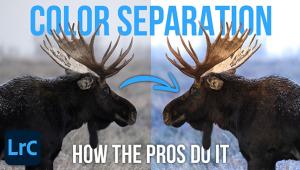Choosing and Using Lenses Page 3
| Image Size & Perspective There are two ways you can change the size of the subject's image on your film. First, you can move closer to the subject (to make it larger on the film) or move farther away (to make it smaller). Second, you can switch to a longer focal-length lens (to make the subject's image larger) or to a shorter focal length (to make it smaller). Each of these ways produces a specific effect. Actually moving the camera closer to the subject will increase the size of the subject's image on the film, but will also change the subject's size relative to other objects in the scene (i.e., it will change the perspective of the image). Changing to a longer focal length lens will increase the size of everything in the scene equally; it will not change the perspective. The next time you're watching a movie or television show and wonder whether a particular "move-in" was done by zooming a zoom lens or by actually moving the camera closer, check the perspective. If the other objects in the scene retain their sizes relative to the main subject, it's a zoom; if the size relationship between elements of the scene changes, it's a camera move. Perspective changes when the camera moves; changing focal lengths from a given camera position won't change perspective. The accompanying photos should make this clear. Apertures The size of the aperture is controlled by the lens' aperture ring. This ring is calibrated in f-numbers. F-numbers represent ratios: the ratio between the diameter of the aperture and the focal length of the lens. When the aperture ring is set at 4 (known as f/4), the diameter of the opening is 1/4 the focal length of the lens. With a 100mm lens, the aperture is thus 25mm in diameter when the aperture ring is set to f/4. Diagram A shows the relative diameters of apertures from f/1.4 to f/16. The aperture represented by each successive numerically larger f-number transmits half as much light as the previous number. For example, f/8 transmits half as much light as f/5.6. For another example, an aperture of f/2 transmits four times as much light as f/4, because its diameter is twice as large as f/4 and thus its opening is four times the area of f/4. Since the f-number system is based on the ratio between the aperture diameter and the focal length of the lens, in theory a given f-number transmits the same amount of light on any focal-length lens. For example, f/8 on a 100mm lens theoretically transmits the same amount of light as f/8 on a 1000mm lens. (Of course, f/8 on the 1000mm lens means an aperture diameter of 125mm, while f/8 on the 100mm lens means a diameter of 12.5mm. That's one reason why you don't see long lenses with large maximum apertures: a 1000mm f/1.4 lens would need an effective aperture diameter of 714mm, or about 28 inches!) Lenses with large maximum apertures are termed "fast": an 85mm f/1.4, or Canon's 50mm f/1.0, for example. Lenses with small maximum apertures are considered "slow": a 50mm f/3.5 macro lens, or a 500mm f/8 mirror lens, for example. Faster lenses provide brighter viewfinder images for easier focusing, and they permit shooting in dimmer light, but they are also more expensive, heavier and generally not as sharp at maximum aperture. Depth of Field Many of today's 35mm SLR cameras offer a depth-of-field preview, which stops the lens down to the set aperture so you can see in the viewfinder how much depth of field you have at any aperture. Important point: When you stop the lens down, it transmits less light, so the image you see in the viewfinder gets darker. At small apertures in dim light, the viewfinder image might be too dark to allow you to analyze depth of field. For example, if you have an f/2 lens and stop it down to f/16, you'll cut the light to 1/64 what it is at f/2—the viewfinder image will be 1/64 as bright. In this case, or if the camera has no depth-of-field preview, you can use the depth-of-field scale on many lens barrels to see approximately how much depth of field you have at a given f-stop and focusing distance. One more thing: Depth of field is really an illusion. The point focused upon is "sharp"; as a subject moves closer or farther away, it becomes less sharp. Within depth-of-field limits, objects will appear acceptably sharp (because their circles of confusion will be sufficiently small), but for maximum sharpness, try to focus accurately. Depth of field affects what appears to be in focus behind and in front of the focused subject, and should not be confused with depth of focus, which is the minute amount the film plane can move toward or away from the lens before the circles of confusion become large enough to noticeably affect image sharpness. Interchangeable Lenses Lenses whose focal length is close to the diagonal measurement of the image frame for a given camera format are considered "normal" lenses for that format. For example, a full-frame 35mm image measures 24x36mm, and has a 43mm diagonal. So 50mm lenses are considered "normal" for 35mm cameras, 50mm being the closest focal length to 43mm that most lens makers offer. Normal lenses see things pretty much as our eyes do, and are good for general picture-taking. There was a time when most SLR camera bodies were sold with a normal lens, but today, bodies are generally sold with short-range zoom lenses, such as 35-80mm. |
- Log in or register to post comments


























































